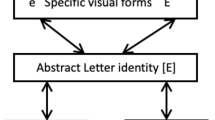Summary
The study investigates the question whether during recognition of a complex Kanji character readers also access the meaning of opaque components of the character. The experiment used a speeded semantic-categorization task of two characters, in which readers were requested to decide whether two characters represented words related in meaning or not. The control pairs consisted of (a) graphically similar, but semantically unrelated, characters, and (b) a simple character and a complex character, of which the simple character was a component (part-whole relation), the two characters being again semantically unrelated. The critical pairs consisted of two characters unrelated in meaning, one of which contained an opaque component element related in meaning to the other character. A corresponding trial with English and its alphabetic system would be to ask a subject to decide whether boycott is related in meaning to girl or not. In this condition the subject is expected to give a No response, but if the pseudocomponent boy is activated, interference could occur. (If boy is recovered during recognition of the pseudocompound boycott, the appropriate No response for boycott-girl could become more difficult to take.) The result of the experiment indicated interference in all three conditions (graphically similar characters, part-whole related characters, and opaque-component related characters. Thus, in an analogous task with alphabetic material, it would be more difficult to say No about the existence of a semantic relation between (a) tree and free, (b) boy and boycott, and (c) boycott and girl. The last result can be interpreted as offering evidence for the activation of the opaque component upon recognition of the complex character.
Similar content being viewed by others
References
Adrews, S. (1986). Morphological influences on lexical access: Lexical or non-lexical effects? Journal of Memory and Language, 25, 726–740.
Balota, D. (1983). Automatic syntactic activation and episodic memory encoding. Journal of Verbal Learning and Verbal Behavior, 22, 88–104.
Coolen, R., v. Jaarsveld, H. J., & Schreuder, R. (in press). The interpretation of isolated novel nominal compounds. Memory & Cognition.
Flores d'Arcais, G. B. (1988). Language perception. In F. Newmeyer (Ed.), Cambridge linguistics. Vol. III. Cambridge: Cambridge University Press.
Flores d'Arcais, G. B., & Saito, H. (1989). Semantic activation and lexical decomposition in the recognition of complex kanji characters. In A. F. Bennett & K. M. McConckey (Eds.), Cognition in individual and social contexts (pp. 101–109). Amsterdam: Elsevier.
Forster, K. I. (1976). Accessing the mental lexicon. In R. J. Wales & E. Walker (Eds.), New approaches to language mechanisms. Amsterdam: North Holland.
Henderson, L. (1985). Towards a psychology of morphemes. In A. W. Ellis (Ed.), Progress in the psychology of language. London: Lawrence Erlbaum Associates.
Lima, S. D., & Pollatsek, A. (1983). Lexical access via an orthographic code? The Basic Orthographic Syllable Structure (BOSS) reconsidered. Journal of Verbal Learning and Verbal Behavior, 22, 310–392.
Marcel, A. J. (1983). Conscious and unconscious perception: An approach to the relations between phenomenal experience and perceptual processes. Cognitive Psychology, 15, 238–300.
Monsell, S. (1985). Repetition and the lexicon. In A. W. Ellis (Ed.), Progress in the psychology of language. London, Hillsdale, NJ: Lawrence Erlbaum Associates.
Murrell, G., & Morton, J. (1974). Word recognition and morphemic structure. Journal of Experimental Psychology, 102, 963–68.
Navon, D. (1977). Forest before trees: The precedence of global features in visual perception. Cognitive Psychology, 9, 353–383.
Osgood, C. E., & Hoosain, R. (1974). Salience of the word as a unit in the perception of language. Perception & Psychophysics, 15, 168–82.
Sandra, D. (1990). On the representation and processing of compound words: Automatic access to constituent morphemes does not occur. Quarterly Journal of Experimental Psychology, 42 A, 529–567.
Taft, M. (1979). Lexical access via an orthographic code. The Basic Orthographic Syllabic Structure (BOSS). Journal of Verbal Learning and Verbal Behavior, 18, 21–39.
Taft, M. (1985). The decoding of words in lexical access: A review of the monographic approach. In D. Besner, T. Gary Weller, & G. E. MacKinnon (Eds.), Reading research: Advances in theory and practice. Vol. 5. Orlando, FL: Academic Press.
Taft, M., & Forster, K. I. (1976). Lexical storage and retrieval of polymorphemic and polysyllabic words. Journal of Verbal Learning and Verbal Behavior, 15, 607–20.
Umemoto, T. (1969). Japanese association norms. Tokyo: Tokyo University Press.
Author information
Authors and Affiliations
Additional information
This account is somewhat oversimplified. It is not always easy to determine which is a radical in a complex character. A higher radical can in fact be a combination of a lower radical with the addition of one or more strokes.
Rights and permissions
About this article
Cite this article
Flores d'Arcais, G.B., Saito, H. Lexical decomposition of complex Kanji characters in Japanese readers. Psychol. Res 55, 52–63 (1993). https://doi.org/10.1007/BF00419893
Received:
Accepted:
Issue Date:
DOI: https://doi.org/10.1007/BF00419893




